
Stand Up For Solar
Protecting rooftop solar in California
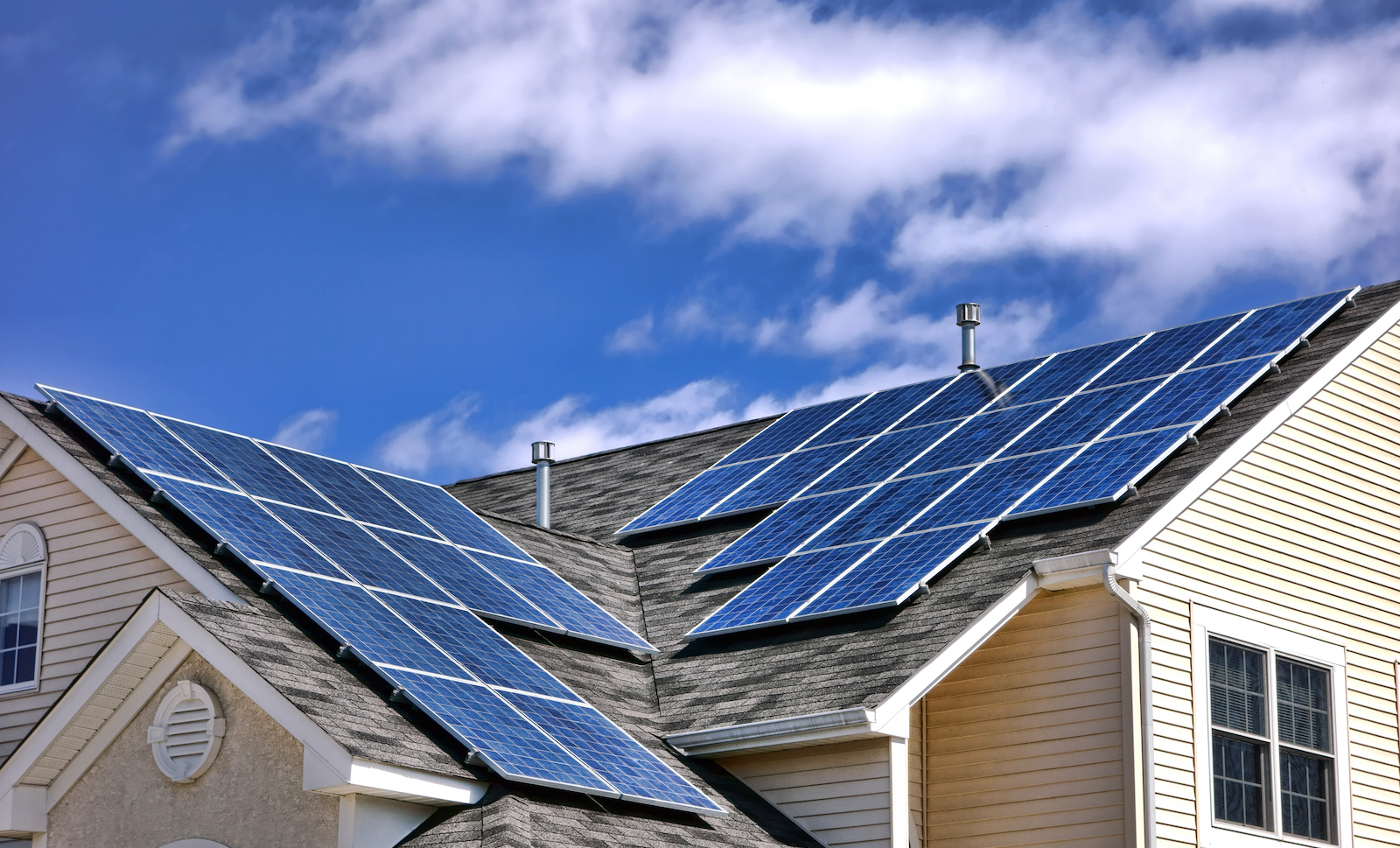
Today, California faces its biggest environmental challenge: climate change. Over the next several decades, California will need to repower its economy with clean, renewable energy – and do so with as little impact as possible on wildlife and wild places.
Rooftop solar power is a key tool in the fight against climate change. Solar energy on homes, schools, farms and other buildings can be deployed at the speed and scale required to meet the climate crisis, and it can do so while contributing to a resilient, ecologically vibrant future for California.
Installing more rooftop solar can increase renewable electricity generation while protecting the state’s open spaces and helping to make communities more resilient to global warming-related disruptions to the power grid. To accelerate the transition to a 100% clean energy system while protecting our environment, California should adopt policies that continue the growth of solar power on homes, businesses, schools, farms and other buildings.
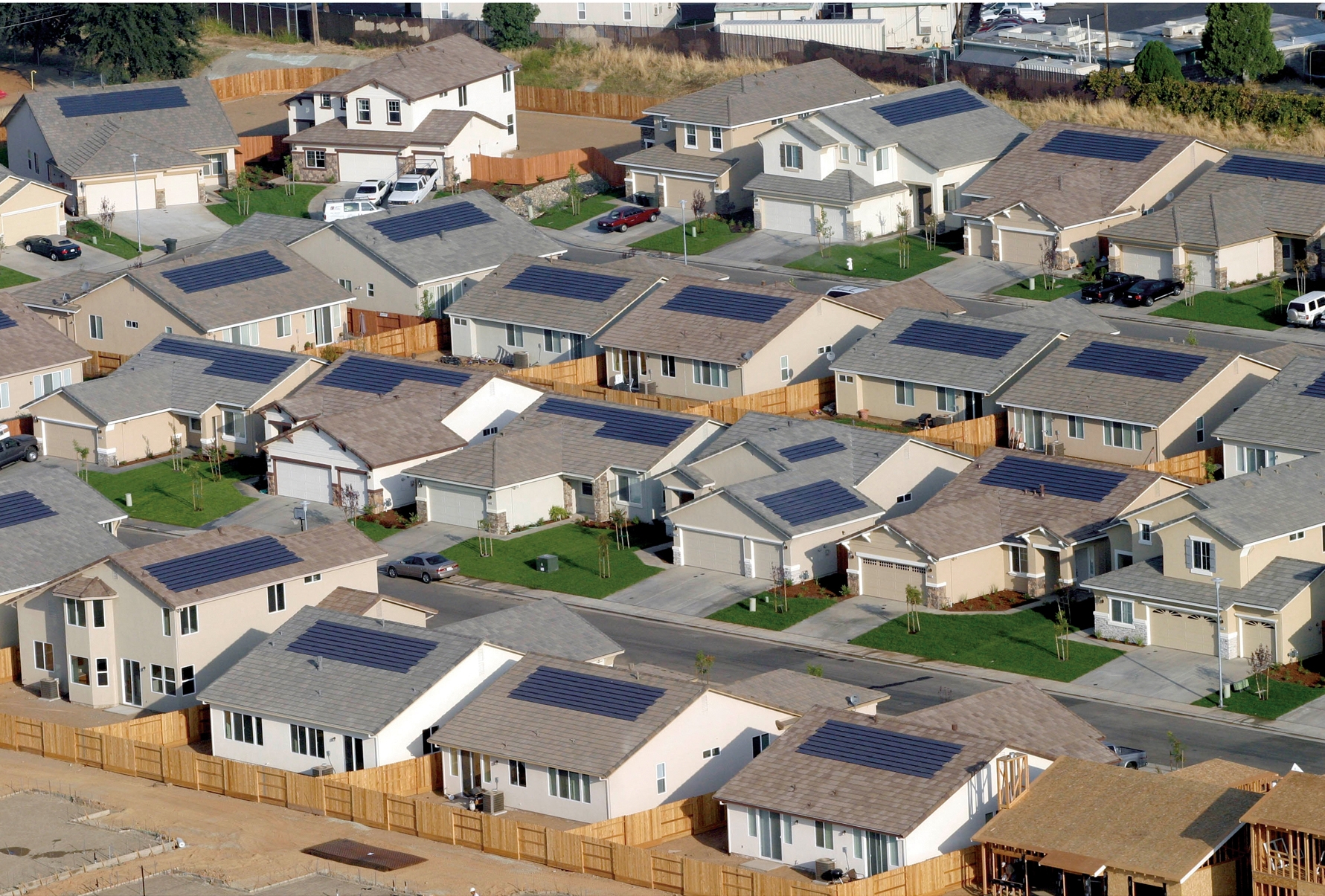
Rooftop Solar at Risk
Cuts to net metering could threaten California’s clean energy progress
A Report by Environment California Research & Policy Center, CALPIRG Education Fund and Frontier Group
Written by Laura Deehan, Environment California Research & Policy Center, Bronte Payne, Environment America Research & Policy Center, Tony Dutzik, Frontier Group and Bryn Huxley-Reicher, Frontier Group.
Rooftop solar power is an essential tool for California to meet its ambitious climate and clean energy goals. California has become the nation’s solar energy leader by adopting policies that have nurtured and grown the state’s market for distributed solar panels on homes and businesses consistently, year after year.
Today, however, utilities and their allies are pushing for major rollbacks to the state’s key policy for compensating solar panel owners for the surplus energy they share back to the electric grid – called “net metering.” Such a rollback would likely slow down rooftop solar adoption dramatically, threatening California’s continued clean energy progress.
Evidence from California and around the United States shows that the pace of solar adoption is dependent on the level of compensation provided to solar panel owners. The case studies in this report, taken from states from Hawaii to Missouri and from across California, show that policy changes like sharply reducing net metering payments and imposing high, solar-only fixed charges that reduce the economic viability of solar power can slow its growth – and, in the most extreme cases, can cause solar installations to plummet.
California cannot afford a “solar cliff” and still meet its climate and energy goals. The California Public Utilities Commission (CPUC) must adopt an approach to net metering (NEM 3.0) that facilitates the continued growth of rooftop solar power.
California needs rooftop solar to meet its ambitious climate and energy goals.
- California has committed to achieving 60% renewable electricity by 2030 and 100% clean, zero-carbon electricity by 2045.
- Modeling conducted for the state of California assumes that, to meet those goals, California will need to continue to add nearly as much rooftop solar as we currently do, every year through 2045.
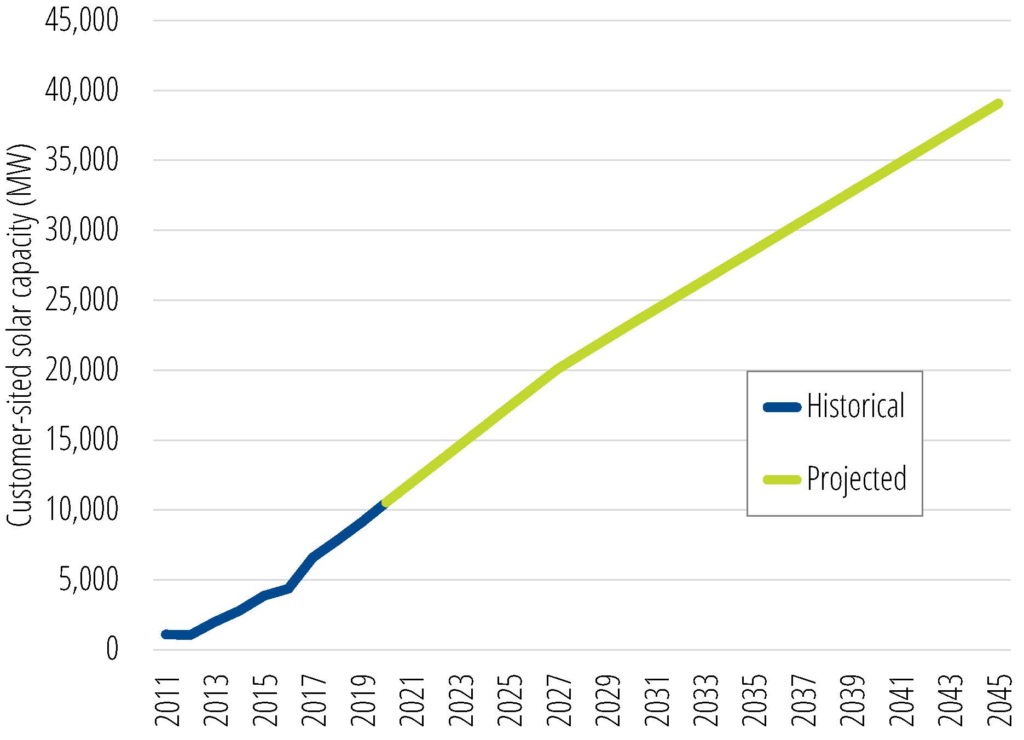
Photo by Frontier Group | TPIN
- Rooftop solar is a uniquely powerful and beneficial way to reach California’s clean energy goals – reducing conflicts between land preservation and renewable energy production, reducing the need for expensive long-distance transmission infrastructure, and helping to build an electricity system more resilient to wildfires and other climate-related disasters.
California’s strong and consistent net metering policies have helped facilitate the growth of solar energy.
- California is the nation’s rooftop solar energy leader. As of the end of 2020, California had 38% of the nation’s small-scale solar photovoltaic (PV) capacity despite accounting for less than 7% of the nation’s electricity consumption.
- California has adopted a series of policies to encourage the growth of rooftop solar, from the Million Solar Roofs program adopted in 2006 to the state’s net energy metering (NEM) 1.0 and 2.0 policies. Net metering has enabled distributed solar customers to be compensated at the retail rate for the surplus electricity they supply to the grid.
- Electricity bill savings are the most important source of value for California homeowners and businesses who “go solar.” Net metering is a critical determinant of the amount of money solar panel owners will save on their electricity bills.
- California’s three investor-owned utilities – those governed by the state’s net metering policies – have experienced steady, consistent growth in customer solar adoption (see Figure ES-2), making them the top three utility territories in the nation for rooftop solar.
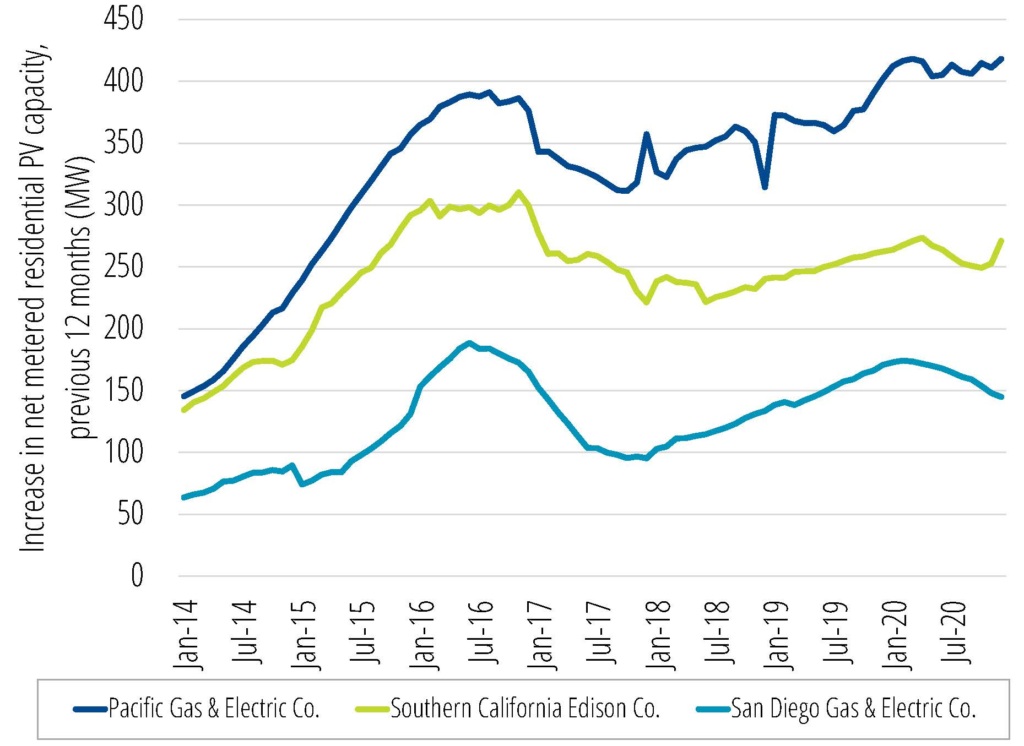
Photo by Frontier Group | TPIN
Reducing compensation to solar consumers reduces solar adoption – often dramatically.
- Utilities in California and elsewhere have pushed for several types of policy changes to reduce solar compensation, including reducing net metering rates and creating new fixed charges (either for solar customers only or all customers).
- A recent study of changes to net metering around the country commissioned by California’s three large IOUs concluded that “net metering reforms may have had a significant impact on residential solar adoption rates in several states.”
- Would-be solar customers are sensitive to the expected financial performance of their investment. A 2014 study by researchers with the National Renewable Energy Laboratory (NREL) estimated that half of potential new residential solar consumers would be willing to consider solar if the payback period was six years or less. That percentage drops to 20% for payback periods of 10 years or more.
The experience of California’s publicly owned utilities and other states around the country illustrates the impact of compensation changes on solar adoption.
- In Arizona, the Salt River Project adopted new fees and policies for rooftop solar that nearly doubled the payback time of solar projects. Researchers estimated that the policy change led to a decline in solar adoption of between 50% and 95%.
- In Hawaii, ending net metering in 2015 led to a sharp slowdown in the state’s booming rooftop solar industry. Hawaii installed roughly half as much residential rooftop solar between 2015 and 2018 as it had in the previous three years, despite sharp declines in worldwide solar prices during that time.
- An attempt to roll back net metering in Nevada led to two years of instability and decline in the state’s solar market. A study filed by California’s IOUs as part of the current NEM 3.0 proceeding found that Nevada’s January 2016 cut to net metering compensation was followed by a 47% reduction in residential solar installations over the next year (compared with the 12 months preceding the change). The September 2017 restoration of net metering was followed by an increase in solar adoption that eventually led residential rooftop solar adoption to return to its earlier level.
- Missouri had a nascent but growing solar market in the early 2010s, fueled by a system of rebates. The removal of those rebates caused the market to crash. New residential additions of rooftop solar in the territories of Missouri’s three major IOUs fell from 23 megawatts (MW) in the 12 months ending June 2014 to 7 MW in the ensuing 12 months – a decline of 70%.
- Similar declines in solar adoption have followed rate changes at California’s publicly-owned utilities, which are not required to follow the CPUC net metering policies.
- The Imperial Irrigation District abandoned net metering in July 2016, causing residential solar installations to fall from a peak of more than 11 MW per year to less than 2 MW annually two years later – a decline of 88%.
- The Modesto Irrigation District reduced net metering compensation in January 2017. Over the course of the next year-and-a-half, residential solar installations fell from more than 6 MW per year to just over 2 MW – a decline of 64%.
- The Turlock Irrigation District ended net metering at the beginning of 2015. Within two years, annual residential solar installations had fallen from 3.5 MW to less than 1 MW – a decline of 74%.
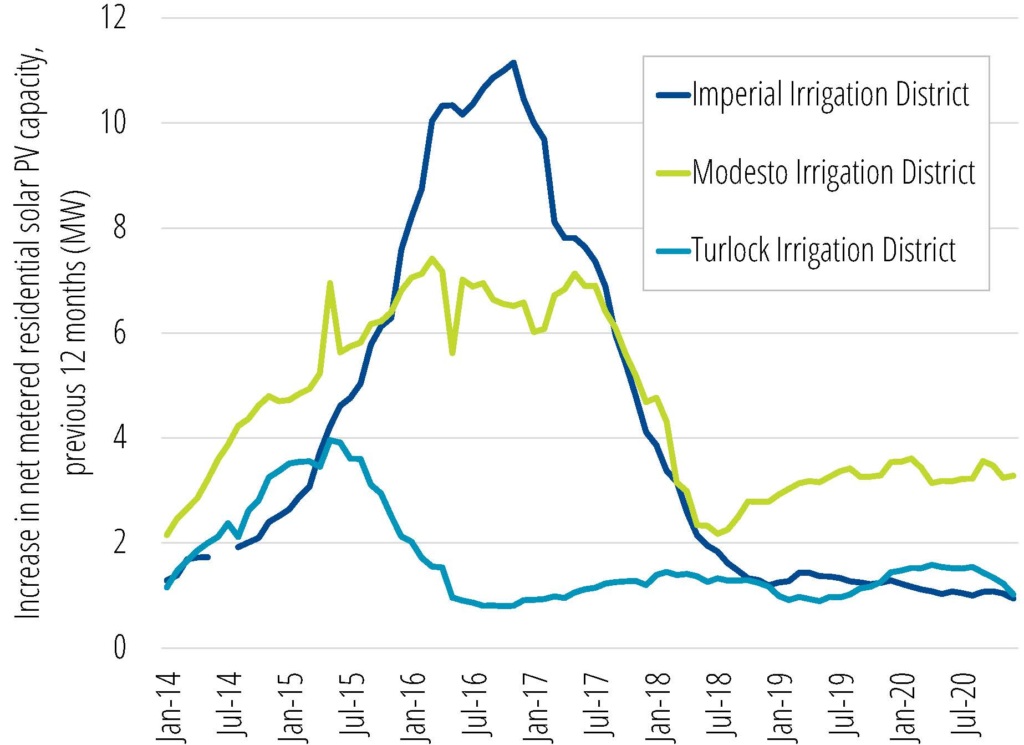
Photo by Frontier Group | TPIN
Policy Recommendations
The CPUC must adopt a new version of net metering that assures the continued growth of rooftop solar in California.
- As California updates its net energy metering policy, it should ensure that the revised policy provides sufficient support to allow the undiminished growth of rooftop solar. Slower growth of distributed solar creates a risk that the state will not meet its climate and clean energy targets.
- California should seek to accelerate solar energy adoption on affordable and rental housing, including by allowing financing through utility bills and ensuring that solar owners who pay reduced rates are fully compensated for the power they provide to the grid.
- In addition, cities and counties should establish online automated permitting systems for standard onsite solar projects to speed up permit approvals and reduce “soft costs” resulting from installation delays, using systems like SolarAPP+ developed by the National Renewable Energy Laboratory.
The Environmental Case for Rooftop Solar Energy
Protecting California’s climate and land
A Report by Environment California Research & Policy Center and Frontier Group
Written by Laura Deehan, Environment California Research & Policy Center and Bryn Huxley-Reicher, Frontier Group.
Rooftop solar is critical to helping California meet its climate goals. California has set out to achieve net-zero greenhouse gas emissions by 2045 and also to obtain 100% of retail electricity sales from renewable and zero-carbon sources by 2045.
- State officials assume that California will nearly quadruple its current rooftop solar capacity – from 10.5 gigawatts to 39 gigawatts (GW) – as it seeks to reach its 2045 climate and clean energy goals. This is in addition to even larger amounts of utility-scale solar.
- California has extensive potential for generating more electricity from rooftop solar installations. A 2016 analysis by the National Renewable Energy Laboratory found that the state has the technical potential to meet more than three quarters of its electricity demand with rooftop solar energy.
Rooftop solar can be installed more quickly than any other electricity generating source, enabling California to respond at the speed and scale necessary to address the climate crisis.
- A residential rooftop solar project is typically installed within three months of inception, and commercial rooftop installations typically take between two and four months.
- Avoiding climate emissions today can help limit the extent of warming that the state and the rest of the world will experience. Pollution reductions today provide greater benefit than the same emission reductions a year or 10 years in the future.
Rooftop solar energy does not change existing land uses and can help California protect agricultural land, fragile habitats and natural areas. These places are disrupted by utility-scale solar projects, which California will need to meet its climate and clean energy goals. However, by tapping rooftop solar opportunities, California can reduce the total amount of utility-scale solar needed and help to protect natural areas. State regulators calculate an additional 28.5 GW of rooftop solar will be built by 2045. By using this amount of rooftop solar instead of utility-scale solar, California can maintain existing land uses on more than 148,000 acres of land – an area about half the size of the City of Los Angeles.
- In October 2020, Governor Gavin Newsom issued an executive order committing California to protecting 30% of its natural land and water areas by 2030, up from the 22% that is protected currently. Rooftop solar can help minimize conflicts between the state’s conservation and clean energy goals.
- Rooftop solar is built on already developed land. By reducing the need for utility-scale facilities, it can reduce the impacts of electricity generation on the natural environment that California is seeking to protect.
- An additional land conservation benefit of rooftop solar is that it produces electricity close to where it is consumed. As a result, it reduces the need for new transmission infrastructure, which can damage or destroy farmland and ecosystems.
Climate change will have disruptive effects on California, even if we move quickly to curb emissions. Rooftop solar energy and batteries can help California communities be more resilient to climate-related disruptions to the electricity grid. When paired with energy storage, solar on homes, businesses, schools and other locations can help buildings or communities keep the power on during emergencies.
- Californians have experienced numerous climate-related blackouts in recent years, both during pre-emptive power shut-offs intended to prevent transmission lines from sparking fires in drought-stressed forests and during unprecedented heat waves when electricity demand outstripped supply.
- If a rooftop solar system is connected to battery storage, the energy the solar panels generate can be used to power a home even when the rest of the grid loses power. This can keep food cold, operate well-water pumps, and provide cooling and lighting.
Policy recommendations
To ensure the installation of enough solar on homes, businesses, schools, farms and other buildings to meet its climate and clean energy goals, California needs a range of policies supporting rooftop solar generation.
- As California updates its net energy metering policy, which allows the owners of rooftop solar panels to be compensated for the electricity they provide to the power grid, it should ensure that the revised policy provides sufficient support to allow the undiminished growth of rooftop solar. Slower growth of distributed solar creates a risk that the state will not meet its climate and clean energy targets.
- California should seek to accelerate solar energy adoption on affordable and rental housing, including by allowing financing through utility bills and ensuring solar owners who pay reduced rates are fully compensated for the power they provide to the grid.
- In addition, cities and counties should establish online automated permitting systems for small onsite solar projects, using systems like SolarAPP+ developed by the National Renewable Energy Laboratory.
Blocking Rooftop Solar
The companies, lobbyists and front groups undermining local clean energy
A report by Environment America Research & Policy Center, U.S. PIRG Education Fund and Frontier Group
Written by Bronte Payne, Environment America Research & Policy Center, Matt Casale, U.S. PIRG Education Fund and J. David Lippeatt, Adrian Pforzheimer and Bryn Huxley-Reicher, Frontier Group.
A national lobbying network is active against solar
In 2021, a national network of utility interest groups and fossil fuel-linked think tanks continues to offer funding, advice and support to utilities across the country seeking to undermine rooftop solar power. These include:
- Edison Electric Institute (EEI), the trade group that represents United States investor-owned electric utilities, developed the model for utilities to use in attacking solar at the state level. EEI worked with the American Legislative Exchange Council to create model legislation to attack net metering. EEI has trained utility executives in how to run advocacy campaigns and has consistently been a major donor to national Congressional candidates and parties.
- The Consumer Energy Alliance (CEA) is a Houston-based front group for the utility and fossil fuel industry, representing companies like Florida Power & Light, ExxonMobil, Chevron and Shell Oil. CEA has spent resources or shipped representatives across the country to help utilities fight their battles in states like Florida, Indiana and Utah.
- American Legislative Exchange Council (ALEC) is a nationwide organization funded in part by anti-solar interests including major utilities, fossil fuel companies and affiliated lobby groups. ALEC claims to be primarily a membership organization but is dominated by its corporate and other outside donors, who provide 98 percent of its budget. It has worked for years to fight renewable energy and pro-solar policies across the country by coordinating with utilities and other local special interests and introducing legislation through policymakers who are ALEC members.
- The Koch organization has provided funding to the national fight against solar by funneling tens of millions of dollars through a network of opaque nonprofits. The Koch-funded campaign organization Americans for Prosperity (AFP) has carried out extensive anti-solar organizing efforts. Koch organizations have directly supported utility fights against solar power in a number of states.
How utilities work to block residential solar
Rooftop solar power has changed America’s energy landscape, giving people the ability to transform their homes to be clean energy producers instead of dirty energy consumers. But instead of embracing this success story, utilities and other special interests are getting together to undermine rooftop solar by making it more expensive — just as it is proving its importance to America’s clean energy future.
Utilities in many states, including California, have worked with national anti-solar groups to undermine pro-solar policies.
California’s major IOUs – Pacific Gas & Electric (PG&E), Southern California Edison (SoCal Edison) and San Diego Gas & Electric (SDG&E) – are pushing for dramatic changes in the net metering policies that have helped the state become the nation’s leader in rooftop solar adoption. The utilities’ proposal would create the nation’s highest fixed charges for solar customers while slashing net metering payments. The changes would severely hamper the state’s solar market at a moment when the state must accelerate clean energy deployment to meet its climate and energy goals. The California Public Utilities Commission is expected to rule on the future of net metering in the state near the end of 2021.
Policy recommendations
State decision-makers, including legislators, utility oversight boards and others, should resist efforts by utilities and their special interest supporters to limit the spread of rooftop solar, including to marginalized communities. Decision-makers should reject these groups’ efforts to weaken pro-solar policies, including:
- Caps, restrictions on or elimination of net metering;
- Rollbacks or elimination of state renewable energy standards;
- Unfair or discriminatory charges or tariffs on solar power system owners;
- Utility rate structures that penalize or discourage solar installation; and
- Other unneeded regulatory burdens on solar energy.
States should also promote and defend policies that support the growth of rooftop solar and speed the national transition toward 100 percent renewable energy. These include:
- Considering the full benefits of distributed solar energy to the grid, to ratepayers and to society in solar energy ratemaking or policy decisions;
- Implementing strong net metering and interconnection standards, which enable many customers to meet their own electricity needs with solar power;
- Supporting community shared solar projects and virtual net metering, which can expand public access to solar power;
- Enacting or expanding solar carve-outs and renewable electricity standards;
- Enabling financing mechanisms to allow for greater solar access for businesses and individuals;
- Allowing companies that are not utilities to sell or lease solar power to residents and businesses; and
- Investing wisely in making the electric grid more intelligent, which will facilitate a greater role for distributed sources of energy such as solar power.
In addition, policymakers should reaffirm and strengthen U.S. national and international commitments to reduce emissions that cause global warming. Solar power will play an increasing role in reducing U.S. carbon emissions, shrinking the carbon footprint of our energy production and usage, and moving the country toward a cleaner future.
Topics
Authors
Steven King
Clean Energy Advocate, Environment California
Steven leads Environment California’s campaigns to increase clean, renewable energy throughout the Golden State, spearheading efforts to transition away from dangerous fossil fuels and address climate change. Steven lives in Los Angeles where he enjoys spending time outdoors, watching his favorite L.A. sports teams, and playing the trombone.
Find Out More

Which 10 American retailers can lead the way on rooftop solar?
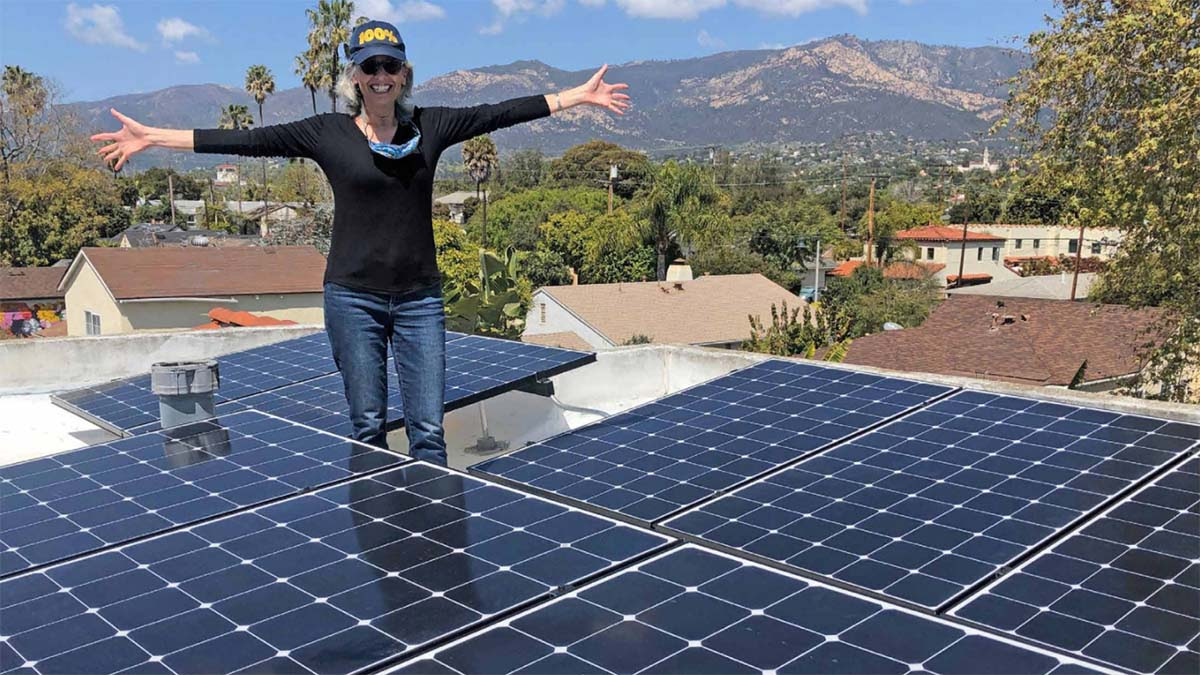
More rooftop solar, less red tape

Establish the true value of rooftop solar



